Accelerate > Publications
Search this online library featuring the latest FAO publications, issue papers and briefs which offer up-to-date knowledge and innovative insights for SDG acceleration.

Hunger Hotspots: FAO-WFP early warnings on acute food insecurity, November 2023 to April 2024 outlook
2023
The Hunger Hotspots report by WFP and FAO identifies 18 hunger “hotspots” in a total of 22 countries where food security is expected to significantly deteriorate, and the outlook for the next six months from November 2023 to April 2024.

The State of Food Security and Nutrition in the World 2023 - Urbanization, agrifood systems transformation and healthy diets across the rural–urban continuum
2023
This report provides an update on global progress towards the targets of ending hunger (SDG Target 2.1) and all forms of malnutrition (SDG Target 2.2) and estimates on the number of people who are unable to afford a healthy diet. Since its 2017 edition, this report has repeatedly highlighted that the intensification and interaction of conflict, climate extremes and economic slowdowns and downturns,...
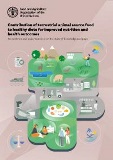
Contribution of terrestrial animal source food to healthy diets for improved nutrition and health outcomes - An evidence and policy overview on the state of knowledge and gaps
2023
FAO’s Committee on Agriculture requested a comprehensive, science- and evidence-based global assessment of the contribution of livestock to food security, sustainable food systems, nutrition and healthy diets, considering environmental, economic and social sustainability. The assessment consists of four component documents. This first component document provides a holistic analysis of the contribution of terrestrial animal source food to healthy diets for....
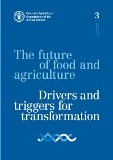
The future of food and agriculture – Drivers and triggers for transformation
2022
This report aims at inspiring strategic thinking and actions to transform agrifood systems towards a sustainable, resilient and inclusive future, by building on both previous reports in the same series as well as on a comprehensive corporate strategic foresight exercise that also nurtured FAO Strategic Framework 2022–31. It analyses major drivers of agrifood systems and explores how their trends could determine alternative futures of agrifood, socioeconomic and environmental systems.

The State of Food Security and Nutrition in the World 2022 - Repurposing food and agricultural policies to make healthy diets more affordable
2022
This year’s report should dispel any lingering doubts that the world is moving backwards in its efforts to end hunger, food insecurity and malnutrition in all its forms. We are now only eight years away from 2030, but the distance to reach many of the SDG 2 targets is growing wider each year. There are indeed efforts to make progress towards SDG 2, yet they are proving insufficient in the face of a more challenging and uncertain context.
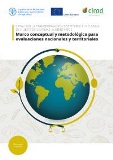
Catalysing the sustainable and inclusive transformation of food systems
2022
Food systems are intimately linked to our lives – through the food we eat, our nutrition and health, our livelihoods, jobs, and the environment and natural resources of the planet. The main challenge for food systems is to produce nutritious food for all while preserving our biodiversity and environment and ensuring equitable distribution of wealth. This brief provides a summarized version of the methodology used to conduct a global assessment of food systems in over 50 countries ...

Maximizing nutrition in crop production using a food systems approach - An evidence-based literature review
2021
This literature review is one of a series of four sector-specific reviews aimed at informing the development of guidance notes for the integration of nutrition across the crops, fisheries, and aquaculture, forestry, and livestock sectors in 12 sub-Saharan African countries. The present literature review focuses on mainstreaming nutrition in the crops sector, using a food systems approach.

Food systems and nutrition - Handbook for parliamentarians N°32
2021
This handbook was prepared by the Inter-Parliamentary Union and the Food and Agriculture Organization of the United Nations, in collaboration with the Scaling Up Nutrition (SUN) Movement, the World Health Organization (WHO), the United Nations Children's Fund (UNICEF) and the African Union Development Agency’s New Partnership for Africa’s Development (AUDA-NEPAD).
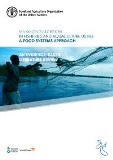
Maximizing nutrition in fisheries and aquaculture using a food systems approach - An evidence-based literature review
2021
This literature review is one of a series of four sector-specific reviews aimed at informing the development of guidance notes for the integration of nutrition across the crops, fisheries and aquaculture, forestry and livestock sectors in 12 sub-Saharan African countries. The present literature review focuses on mainstreaming nutrition in fisheries and aquaculture using a food systems approach.
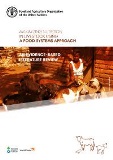
Maximizing nutrition in livestock using a food systems approach - An evidence-based literature review
2021
This literature review is one of a series of four sector-specific reviews aimed at informing the development of guidance notes for the integration of nutrition across the crops, fisheries and aquaculture, forestry and livestock sectors in 12 sub-Saharan African countries. The present literature review focuses on mainstreaming nutrition in the livestock sector using a food systems approach.
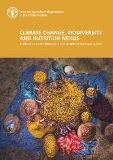
Climate change, biodiversity and nutrition nexus
2021
This paper identifies entry points within agri-food systems to improve biodiversity and diets, two levers that can be used to enhance nutrition and optimize environmental sustainability while ensuring social equity, especially of the most vulnerable people. It also presents recommendations for concrete actions by key stakeholders – governments, academia, civil society, private sector, and development partners –to build resilient, inclusive, and sustainable agri-food systems. KEYWORDS:

Consumer organizations and the right to adequate food - Making the connections
2021
Consumers are a powerful force for change towards a sustainably developing world that leaves no one behind and respects the human rights of all. This publication is aimed at making the connections between the important work of consumer organizations and the realization of the right to adequate food, increasing the visibility of these organizations and highlighting their importance to food security, healthy diets and food systems transformations.
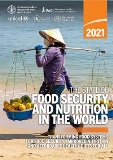
The State of Food Security and Nutrition in the World 2021 - Transforming food systems for food security, improved nutrition and affordable healthy diets for all
2021
In recent years, several major drivers have put the world off track to ending world hunger and malnutrition in all its forms by 2030. The challenges have grown with the COVID-19 pandemic and related containment measures. This report presents the first global assessment of food insecurity and malnutrition for 2020 and offers some indication of what hunger might look like by 2030 in a scenario further complicated by the enduring effects of the COVID-19 pandemic.
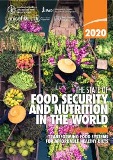
The State of Food Security and Nutrition in the World 2020 - Transforming food systems for affordable healthy diets
2020
Updates for many countries have made it possible to estimate hunger in the world with greater accuracy this year. In particular, newly accessible data enabled the revision of the entire series of undernourishment estimates for China back to 2000, resulting in a substantial downward shift of the series of the number of undernourished in the world.
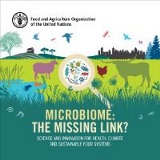
Microbiome: The missing link? Science and innovation for health, climate and sustainable food systems
2019
Unhealthy diets now pose a greater risk to morbidity and mortality than unsafe sex, alcohol, and drug and tobacco use combined. They are at the root of the global obesity and diet-related non-communicable disease (NCD) pandemic. The ways of food production that lead to these unhealthy diets also pose a major threat to climate stability and ecosystem resilience, and constitute the most important driver of environmental degradation and natural resources depletion.
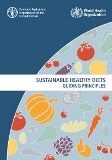
Sustainable healthy diets - Guiding principles
2019
This publication aims to support the efforts of countries as they work to transform food systems to deliver on sustainable healthy diets, contributing to the achievement of the SDGs at country level, especially Goals 1 (No Poverty), 2 (Zero Hunger), 3 (Good Health and Well-Being), 4 (Quality Education), 5 (Gender Equality) and 12 (Responsible Consumption and Production) and 13 (Climate Action).
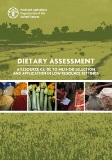
Dietary assessment - A resource guide to method selection and application in low resource settings
2018
FAO provides countries with technical support to conduct nutrition assessments, in particular to build the evidence base required for countries to achieve commitments made at the Second International Conference on Nutrition (ICN2) and under the 2016-2025 UN Decade of Action on Nutrition. Such concrete evidence can only derive from precise and valid measures of what people eat and drink.
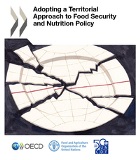
Adopting a Territorial Approach to Food Security and Nutrition Policy
2016
Three-quarters of the world’s extreme poor live in the rural areas of developing countries. This marks not only the scope of the problem, but also identifies a territorial divide. And, not all rural areas are alike. Most rural poor and food insecure live in sub-national regions that are disadvantaged in many other ways: they lack adequate infrastructure and basic services and are more vulnerable to adverse climatic conditions. Continued population growth brings added pressure to..
Browse by SDG
- SDG1: No Poverty
- SDG2: Zero Hunger
- SDG3: Good Health & Well-being
- SDG4: Quality Education
- SDG5: Gender Equality
- SDG6: Clean Water & Sanitation
- SDG7: Affordable and Clean Energy
- SDG8: Decent Work and Economic Growth
- SDG9: Industry, Innovation and Infrastructure
- SDG10: Reduced Inequalities
- SDG11: Sustainable Cities and Communities
- SDG12: Responsible Consumption and Production
- SDG13: Climate Action
- SDG14: Life Below Water
- SDG15: Life on Land
- SDG16: Peace, Justice and Strong Institutions
- SDG17: Partnerships for the Goals
Browse by Better
Browse by Priority Area
- Innovation for Sustainable Agriculture Production
- Blue Transformation
- One Health
- Small-Scale Producers' Equitable Access to Resources
- Digital Agriculture
- Healthy Diets for All
- Nutrition for the Most Vulnerable
- Safe Food for Everyone
- Reducing Food Loss and Waste
- Transparent Markets and Trade
- Climate Change Mitigating and Adapted Agrifood Systems
- Bioeconomy for Sustainable Food and Agriculture
- Biodiversity and Ecosystem Services for Food and Agriculture
- Achieving Sustainable Urban Food Systems
- Gender Equality and Rural Women's Empowerment
- Inclusive Rural Transformation
- Agriculture and Food Emergencies
- Resilient Agrifood Systems
- Hand-in-Hand Initiative
- Scaling up Investment
